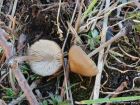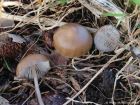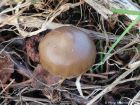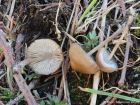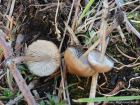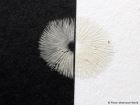Cap parabolical, ranging from campanulate to conical in shape, often flattening with age and developing a broad umbo. It is sometimes somewhat umbilicate. The surface is smooth, hygrophanous, and glabrous. It is not sulcate and only faintly translucent-striate. The texture is slightly lubricous to the touch. The colour ranges from dark chestnut to sepia brown, becoming paler towards the margin. The flesh is pale, watery, and thin. Gills reaching the stipe and ascending, often ventricose and narrowly adnate to adnate. In older specimens, they are dorsally intervenose. The colour ranges from whitish to pale grey, sometimes turning pink with age. Stem straight to curved, hollow, terete, and equal in width, somewhat firm in texture. The surface is glabrous except for a minutely pruinose apex. Colour is grey-brown overall, whitish above, and dark brown towards the base, which is covered with coarse, long, whitish fibrils. The stem lacks a ring. Spore print white.
Microscopic Features: The spores are measuring 7–9.6 × 3.6–5.8 µm. Shape ranges from pip-shaped to phaseoliform. The surface is smooth and spores are amyloid.
Mycena plumipes on the mycena.no Web site.
Many mushrooms are poisonous, and some can be lethally toxic. Distinguishing between edible and poisonous mushrooms can be very challenging. Therefore, we strongly advise against consuming wild mushrooms. This website does not contain any information about the edibility or toxicity of mushrooms.
Although efforts have been made to ensure accuracy on this website, the information may contain errors and omissions. Therefore, all content provided is for educational and informational purposes only and should not be relied upon or used as a basis for consuming any plants or mushrooms.
External links are provided for reference only. We do not endorse or take responsibility for the content, advice, or products found on these sites or in any advertisements shown on this website.
